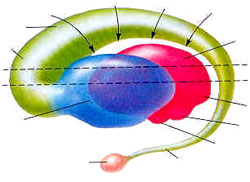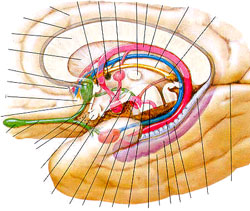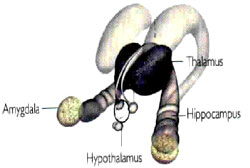|
|
|
11/5/00
from
PsychEducation Website
You may have thought all you
had was one, but inside there are two more brains.
The most illogical or irrational "wants" we have probably
derive from older parts of our brain, while the understanding of smart
versus dumb choices comes from the newest part. If that idea offends
you, or seems just too "Western" or "scientific", you might take a
"de-tour" for a moment and read this essay on science.
Here are the "3 brains":
Brain
One This is the brain we share with birds, and reptiles.
Think of it as the "housekeeping brain". Just the basics: hunger, temperature control, fight-or-flight fear responses, defending territory, keeping safe - that kind of thing. The structures that perform these functions within our brain are extremely similar to those in the brains of reptiles.
Thus, this brain is called the "R complex" (R for reptilian). You can take a Tour of the R complex when you wish; and you will see parts of it in the section on obsessions.
The Latin word
Their brains, and this part of our brains, are
extremely similar. Think about the difference between a mouse and a lizard, or between a cat and a snake, and you'll recognize what this mammalian brain adds to a creature's capacities.
Mammals have "feelings" like ours. We'll be looking at the structures of the limbic system in the sections on mood, memory, and hormone control.
The main parts of the limbic system (except the thalamus, which is generally regarded as part of Brain One) are shown below.
By taking all the Brain Tours you'll see
each of these parts and get a better sense of how this set of structures
is positioned underneath the cortex.
Brain Three
With this
brain, primates can do things that horses and cows
Other primates like chimpanzees, or monkeys, have much less cortex, which is surprising since chimpanzee DNA differs from ours by only 1.6%! (stunning, really; I hope you're stunned.
Recently some technical issues have arisen with this number, but for now, it's still generally regarded as, well, amazing!).
If you wonder why we humans have populated the entire globe, while our chimp relatives are stuck in a shrinking rain forest with their nearly identical DNA - read The Third Chimpanzee, by Jared Diamond. You've got a great question, and his is a great answer.
(Similarly, if you wonder
why white-skinned humans seem to have an unfair share of the resources
and money, his other masterpiece offers a solid explanation beside skin
color: Guns, Germs, and Steel).
The R brain is like a golf club. Let's make it a driver, one of those with a big fat wooden head. Hold the club so that the head is at the top.
There's your R complex, with your spine sticking down toward the ground. The R brain is just a big swelling at the top of a spinal cord, and that's how it developed. Worms have little swellings, snakes have bigger ones.
OK so far? Next we'll add the layer that makes mammals behave so differently from reptiles. This next "layer", the old mammalian brain, evolved on top of the R complex. It was not a remodel so much as an addition, like adding on bedrooms all the way around a kitchen/bathroom.
This addition covers the entire R complex, leaving the R complex deep within the brain. In our model, take the golf club, and cover the head with a sock; a big thick red one would be nice.
Now you have the R brain (golf club), with the
old mammalian brain wrapped around it (sock). Notice that the red sock
forms a shell, or continuous border around the golf club head.
|


 for
arc or girdle is "limbus", and this brain is called the "limbic system".
We humans share this brain with older mammals like dogs, cats, and
horses, and even mice (as opposed to newer mammals like chimps; we'll
get to them in a moment).
for
arc or girdle is "limbus", and this brain is called the "limbic system".
We humans share this brain with older mammals like dogs, cats, and
horses, and even mice (as opposed to newer mammals like chimps; we'll
get to them in a moment).  cannot,
like complex social interactions and advance planning (such as planning
an attack on a neighboring troop). In humans the cortex has grown to a
huge size, somehow in association with our development of language.
cannot,
like complex social interactions and advance planning (such as planning
an attack on a neighboring troop). In humans the cortex has grown to a
huge size, somehow in association with our development of language.
